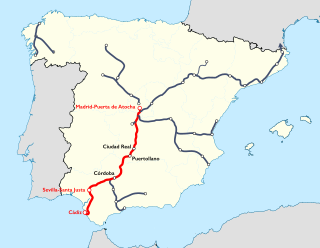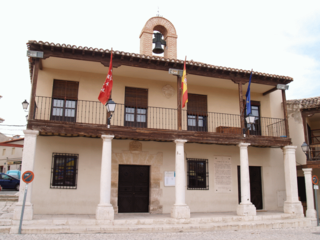Related Research Articles

Transport in Spain is characterised by a network of roads, railways, trams, air routes, and ports. Its geographic location makes it an important link between Europe, Africa, and the Americas. Major forms of transit generally radiate from the capital, Madrid, located in the centre of the country, to link with the capitals of the autonomous communities.

Toledo is a city and municipality of Spain, the capital of the province of Toledo and the de jure seat of the government and parliament of the autonomous community of Castilla–La Mancha.

The Community of Madrid is one of the seventeen autonomous communities of Spain. It is located in the centre of the Iberian Peninsula, and of the Central Plateau. Its capital and largest municipality is the City of Madrid, which is also the capital of the country. The Community of Madrid is bounded to the south and east by Castilla–La Mancha and to the north and west by Castile and León. It was formally created in 1983, in order to address the particular status of the City of Madrid as the national capital city and in urban hierarchy. Its limits are those of the province of Madrid, which was until then conventionally included in the historical region of New Castile.

Aranjuez is a city and municipality of Spain, part of the Community of Madrid.

The Madrid Metro is a rapid transit system serving the city of Madrid, capital of Spain. The system is the 14th longest rapid transit system in the world, with a total length of 293 km (182 mi). Its growth between 1995 and 2007 put it among the fastest-growing networks in the world at the time. However, the European debt crisis greatly slowed expansion plans, with many projects being postponed and canceled. Unlike normal Spanish road and rail traffic, which drive on the right, Madrid Metro trains use left-hand running on all lines because traffic in Madrid drove on the left until 1924, five years after the system started operating.

Renfe, officially Renfe-Operadora, is Spain's national state-owned railway company.

Rail transport in Spain operates on four rail gauges and services are operated by a variety of private and public operators. The total route length in 2012 was 16,026 km.

Cercanías Madrid is the commuter rail service that serves Madrid, the capital of Spain, and its metropolitan area. It is operated by Cercanías Renfe, the commuter rail division of Renfe, the former monopoly of rail services in Spain. Its total length is 370 km.

Ciempozuelos is a municipality in Spain located in the Community of Madrid. The municipality spans across a total area of 49.64 km2 and, as of 1 January 2020, it has a registered population of 25,383 (2022).
High-speed railways in Spain are in operation since 1992 when the first line was opened connecting the cities of Madrid, Córdoba and Seville. Unlike the rest of the Iberian broad gauge network, the Spanish High-speed network mainly uses standard gauge. This permits direct connections to outside Spain through the link to the French network at the Perthus Tunnel. High-speed trains run on a network of high-speed rail track owned and managed by ADIF, where the dominant service is AVE while other high speed services such as Avant, Alvia, Avlo, Euromed, Ouigo España and Iryo, as well as mid-speed (Altaria) services also operate.
Villaseca de la Sagra is a municipality located in the province of Toledo, Castile-La Mancha, Spain. According to the 2006 census (INE), the municipality has a population of 1,581 inhabitants.

The history of rail transport in Spain begins in the 19th century. In 1848, a railway line between Barcelona and Mataró was inaugurated, although a line in Cuba connecting Havana and Bejucal had already opened in 1837. In 1852 the first narrow gauge line was built, in 1863 a line reached the Portuguese border. By 1864 the Madrid-Irun line had been opened, and the French border reached.

The Madrid–Sevilla high-speed line is a 472-kilometer-long (293 mi) Spanish railway line for high-speed traffic between Madrid and Seville. The first Spanish high-speed rail connection has been in use since 21 April 1992 at speeds up to 300 km/h (186 mph). Travel time between the two end points was reduced by over half.

The Museo del Ferrocarril in Madrid, Spain, is one of the largest historic railroad collections in Europe. It is housed in a redundant railway station called Madrid-Delicias in the barrio of Delicias. The location is near the centre of Madrid.

The Toledo railway station is a railway station in Toledo, Spain, which was designed by architect Narciso Clavería y de Palacios in the Neo-Mudéjar style.

Colmenar de Oreja is a town and municipality of the Las Vegas comarca, in the Community of Madrid, Spain. It was subject to a seven-month siege in 1139.

El Tren de la Fresa or the Strawberry Train is an heritage train service operated on the railway that was inaugurated on 9 February 1851 between Madrid and Aranjuez as the second railway line in mainland Spain. The original purpose of the 49 kilometres (30 mi) railway was to connect Spain's capital with the Royal Palace of Aranjuez. It was called the "Tren de la Fresa", the "Strawberry Train," as it originally went past vast fields of strawberries en route. Fresa con Nata is a speciality produce of the town.

The Madrid–Levante high-speed network is a network of high-speed rail lines that connects Madrid with the Mediterranean coast of the Levante Region, specifically with Castilla-La Mancha, the Valencian Community and the Murcia Region autonomous communities.

Narciso Clavería y de Palacios, 3rd Count of Manila (1869–1935) was a Spanish architect, notable as an exponent of the Moorish revival style known as Neo-Mudéjar. He was the grandson of Narciso Clavería y Zaldúa, a nineteenth-century Governor General of the Philippines from whom he inherited the title of Count of Manila.

Avant is a high-speed, medium-distance passenger transport rail service, operated in Spain by the Spanish public company Renfe. Avant services circulate at a maximum speed of 250 km/h, compared to the 300 km/h maximum speed of the AVE service. Their routes usually cover different provinces within the same autonomous community or between neighboring ones. Regional services at conventional speed are called Renfe Media Distancia.
References
- 1 2 Hernando, Silvia (January 2020). "Spain's dying railroad towns". El Pais. Retrieved 18 March 2020.
- ↑ "Nomenclátor. Relación de unidades poblacionales". Instituto Nacional de Estadística. Retrieved 25 October 2018.
- ↑ "Historia: Algodor". www.rta.com.es (Red de transportes de Aranjuez) (in Spanish). Retrieved 26 October 2018.
- ↑ "Enclavamiento". www.museodelferrocarril.org/. Archived from the original on 6 November 2018. Retrieved 26 October 2018.
- ↑ "LIFE Project: Recovery of urban environment and biodiversity of Aranjuez".
- ↑ "10 rutas de senderismo". www.guiadelocio.com. Retrieved 27 October 2018.